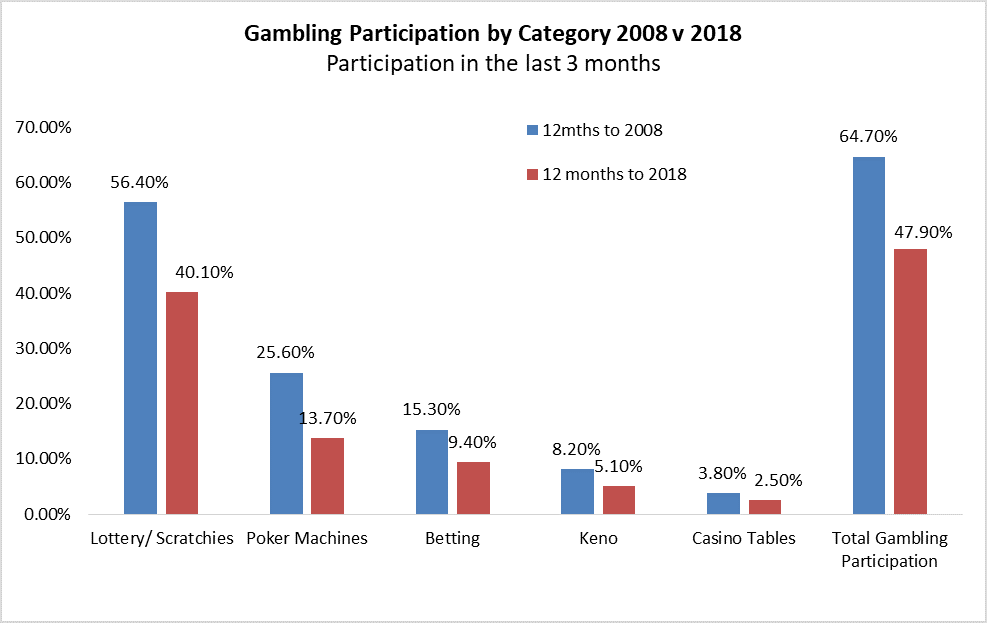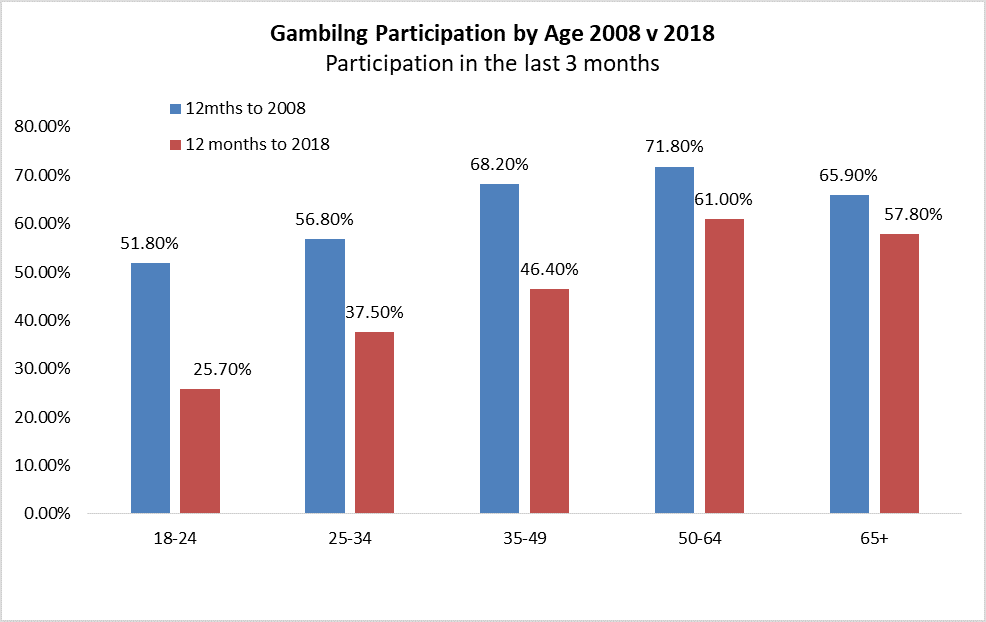FEWER AUSTRALIANS GAMBLING
New data shows that over the last decade there has been a large drop in the proportion of Australians (18+) that gamble. A decade ago (December 2008), nearly two thirds of the population 18+ (64.7% or 10.5 million) gambled in an average three months, this has now fallen in December 2018 to only 47.9% or 9.3 million. This downward trend has continued over the last year, falling from December 2017, which showed that 50.1% of Australians or 9.5 million gambled in an average three months.
These are some of the latest findings from Roy Morgan’s ‘Single Source’ survey, which is based on in-depth interviews conducted face-to-face with over 50,000 consumers per annum in their homes. This survey includes detailed questioning of over 7,000 gamblers per annum from which the comprehensive ‘Gambling Currency Report’ is produced, covering long term gambling trends from 2002. The latest data in this release comes from the December report and covers the 12 months to December 2018.
All gambling categories declining
The following chart shows that not only has the overall proportion of Australians (18+) who have gambled declined over the last decade, from 64.7% down to 47.9% but a decline has occurred across all major types of gambling.
The biggest drop in participation over the decade was for lottery/scratch tickets which were down 16.3% points to 40.1% but remain clearly the most popular gambling category. Poker machines showed the next biggest loss, declining by 11.9% points to 13.7%, followed by betting down 5.9% points to 9.4%.

Source: Roy Morgan Single Source (Australia). 12 months ended December 2008, n=19,968; 12 months ended December 2018, n=14,224. Base: Australians 18+.
Gambling less popular with younger people
The overall participation in gambling is lowest for the 18 to 24 group with 25.7%, followed by the 25 to 34 segment with 37.5%, both well below average. The highest participation is for those aged 50 to 64 with 61.0% and those 65 and over with 57.8%.
Over the last decade the 18 to 24 showed the biggest decline in participation, down 26.1% points, with all ages under 50 showing above the average decline of 16.8% points. By contrast, the 65 and over segment showed a much smaller decline of only 8.1% points.
Gambled in last 3 months – 2008 v 2018 by Age

Source: Roy Morgan Single Source (Australia). 12 months ended December 2008, n=19,968; 12 months ended December 2018, n=14,224 Base: Australians 18+
Betting declining across all age groups
The participation in the high profile betting covering all types of racing and sports betting, has fallen to only 9.5% of the population, from 15.3% a decade ago. All age groups have shown declining participation, with the greatest declines being for those aged under 50.
Betting appears to increase with age, going from only 4.7% for those aged 18 to 24 up 11.7% for the 50 to 64 group. However, the 65 and over segment are around the market average on 9.5% (market average 9.4%).
Norman Morris, Industry Communications Director, Roy Morgan, says:
“Despite a decline in gambling participation over the last decade, just under half (47.9%) of the Australian population over 18 (9.3 million) still engage in at least one of the many gambling options in an average three months. Even with the continued development of online and mobile betting, clearly the most popular form of gambling continues to be lottery/scratch tickets with 40.1%, well ahead of poker machines (13.7%) and betting (9.4%).
“The fact that less Australians of all ages are gambling, in a market with an increasing number of gambling options, is likely to be as a result of it falling out of favour as it competes with a proliferation of other entertainment and leisure activities. Increasing warnings and publicity given to potential gambling problems may also discourage participation.
“It is interesting to note that with the ease of betting on a phone due to the rapid growth of betting apps, that over a quarter (27.4%) of people who have a bet now do so on a mobile phone, compared to only 5.3% six years ago. Although the use of this new technology to place a bet would be expected to attract more young people to bet, this research shows that this is not the case as they have had the biggest declines.
Source: https://www.roymorgan.com/findings/7941-gambling-participators-201904120606













